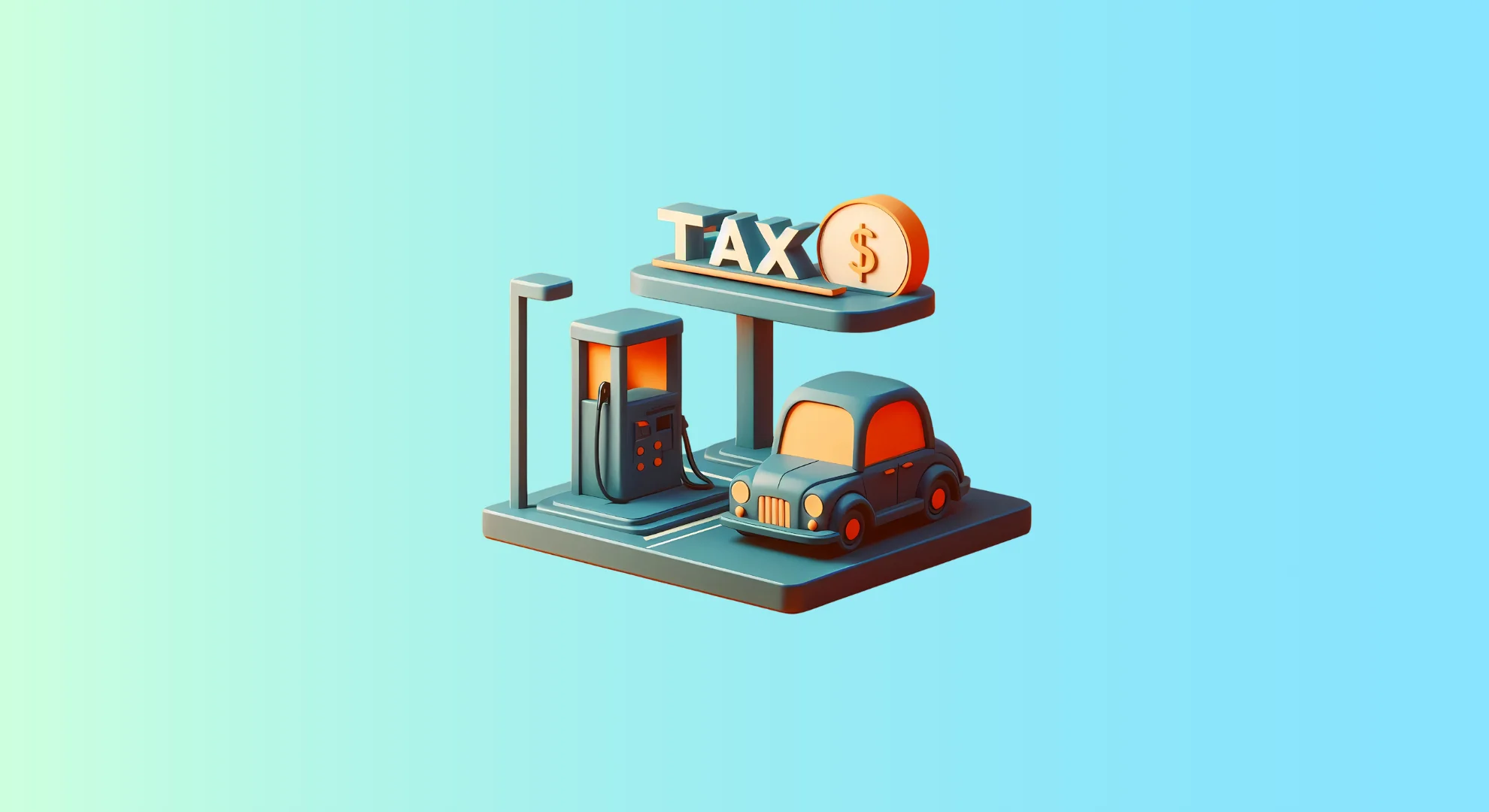The federal gasoline tax, or the federal motor fuels tax, is an excise tax levied on each gallon of gasoline sold in the United States. This tax serves as a critical source of revenue for the Highway Trust Fund, which finances the construction, maintenance, and improvement of the nation’s highway infrastructure system, including interstate highways, federal roads, and bridges.
Table of Contents
What is the Federal Tax on Gasoline?
The federal gasoline tax is a per-gallon excise tax imposed at the wholesale level. Tax is applied when gasoline is transferred from refineries or bulk terminals to distributors or retailers. The tax is currently set at a flat rate of 18.4 cents per gallon for gasoline and 24.4 cents per gallon for diesel fuel.
It’s important to note that the price displayed at gas stations already includes the federal gasoline tax. Additionally, many states and localities levy their gasoline taxes on top of the federal tax, increasing the price at the pump.
Benefits of Federal Tax on Gasoline
The federal tax on gasoline serves several key purposes:
- Funding for Highway Infrastructure: Revenue generated from the federal gas tax is the primary source of funding for the Highway Trust Fund. This fund is crucial for maintaining and improving the nation’s vast network of roads and bridges, ensuring safe and efficient transportation for people and goods.
- Economic Growth: A well-maintained transportation network is essential for economic activity. Efficient highways facilitate the movement of goods and services across the country, promoting trade, commerce, and job creation.
- Safety Improvements: The federal gas tax helps fund projects that enhance road safety, such as bridge repairs, guardrail installations, and intersection improvements. These investments contribute to reducing traffic accidents and fatalities on the nation’s roadways.
| Benefit | Description |
| Funding for Highway Infrastructure | Supports construction, maintenance, and improvement of roads and bridges |
| Economic Growth | Enables efficient movement of goods and services, fostering trade and job-creating |
| Safety Improvement | Funds projects like bridge repairs and guardrail installation, enhancing road safety. |
How does the Federal Tax on Gasoline help maintain Interstate Highways?
Interstate highways form the backbone of the nation’s transportation system, connecting major cities and facilitating commercial traffic across vast distances. The federal gas tax plays a critical role in maintaining these vital roadways:
- Dedicated Funding: Revenue from the federal gas tax flows directly into the Highway Trust Fund, ensuring a dedicated source of income specifically for interstate maintenance and improvement projects.
- Long-Term Planning: The predictable nature of gas tax revenue allows for long-term planning and budgeting for interstate maintenance projects. This facilitates proactive infrastructure management and prevents costly repairs down the road.
- Safety Enhancements: Funds from the gas tax can be used to address safety concerns on interstates, such as improving signage, upgrading guardrails, and implementing traffic calming measures.
It’s important to note that the current funding model for the Highway Trust Fund faces challenges. With increasing fuel efficiency and the growing popularity of electric vehicles, gas tax revenue is projected to decline in the coming years. This raises concerns about the long-term sustainability of interstate maintenance and improvement funding.

How much is the Federal Tax on Gasoline?
The current federal tax on gasoline is set at 18.4 cents per gallon. This rate has remained unchanged since 1993 despite inflation eroding its purchasing power.
Federal Tax on Gasoline (as of June 2024):
| Fuel Type | Federal Tax Rate |
| Gasoline | 18.4 cents per gallon |
| Diesel Fuel | 24.4 cents per gallon |
In addition to the federal tax, most states and localities impose gasoline taxes. These vary significantly across jurisdictions, ranging from a few cents per gallon to over 50 cents per gallon. The combined federal and state gas taxes ultimately determine consumer’s prices at the pump.
History of Federal Tax on Gasoline
The federal gasoline tax has a long and winding history in the United States, shaping the nation’s transportation infrastructure for over nine decades. Here’s a timeline of key developments leading up to 2024:
- 1932: The Great Depression era ushers in the first federal gasoline tax. Initially set at a modest 1 cent per gallon, this tax aimed to generate revenue for desperately needed infrastructure projects during a challenging economic period.
- 1938: The gasoline tax was increased to 1.5 cents per gallon, recognizing its potential as a reliable source of infrastructure funding.
- 1940: The looming threat of World War II necessitates a temporary hike in the gas tax to 2 cents per gallon. This increase was intended to bolster national security efforts during wartime.
- 1945: With the conclusion of World War II, the federal gasoline tax rate reverts to 1.5 cents per gallon.
- 1956: A pivotal year for transportation infrastructure, the Federal Highway Act is enacted. This landmark legislation authorizes the construction of a nationwide interstate highway system, a massive undertaking requiring significant funding. The federal gas tax rate substantially increases to 3 cents per gallon to support this ambitious project.
- 1973: The Arab oil embargo triggers a global energy crisis, leading to significant increases in gasoline prices. In response, Congress considers raising the gas tax to generate additional revenue but ultimately opts against it due to concerns about further burdening consumers already facing high fuel costs.
- 1983: Another significant energy crisis prompts discussions about raising the gas tax. However, like in 1973, consumer pushback concerns prevented tax rate increases.
- 1990: The Omnibus Budget Reconciliation Act of 1990 brings a 5-cent increase to the federal gas tax, raising the rate to 9 cents per gallon. This increase was not solely dedicated to infrastructure; half of the additional revenue was directed toward deficit reduction efforts.
- 1993: The federal gas tax witnesses its most recent increase, rising to its current rate of 18.4 cents per gallon. This increase, implemented under the provisions of the Omnibus Budget Reconciliation Act of 1993, similarly divided the additional revenue between the Highway Trust Fund and deficit reduction.
- Post-1993: Since 1993, the federal gas tax rate has remained unchanged despite significant inflation. This has eroded the tax’s purchasing power and raised concerns about the long-term sustainability of the Highway Trust Fund, especially with the rise of fuel-efficient and electric vehicles.
- The year 2024: As of June 2024, the federal gas tax remains at 18.4 cents per gallon for gasoline and 24.4 cents per gallon for diesel fuel. However, discussions and debates regarding alternative funding mechanisms for the Highway Trust Fund continue, focusing on addressing the challenges posed by declining gas tax revenue and ensuring the long-term health of the nation’s transportation infrastructure.

Conclusion
The federal tax on gasoline plays a vital role in funding the Highway Trust Fund, which supports the construction, maintenance, and improvement of the nation’s transportation network. While the gas tax has historically served its purpose well, declining revenue and inflation challenges raise concerns about its long-term viability. As fuel efficiency and electric vehicles gain traction, policymakers face the task of finding alternative or complementary funding mechanisms to ensure the continued sustainability of our nation’s crucial infrastructure.










